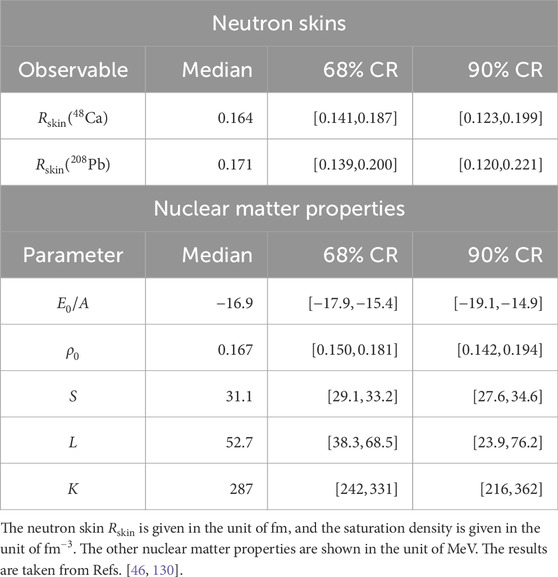- Center for Computational Sciences, University of Tsukuba, Tsukuba, Ibraki, Japan
With the combination of nuclear interactions from chiral effective field theory and various many-body techniques, one can perform systematically improvable ab initio calculations. As the improvable framework enables us to quantify the uncertainty, it is particularly useful to make a prediction for which performing experiments is difficult or even impossible. Neutron skin thickness, the difference between neutron and proton distribution radii, is a key quantity related to the properties of infinite nuclear matter. Since neutrons do not have a net electric charge, the neutron-distribution radius is difficult to measure, preventing precise measurement of neutron skin thickness. On the other hand, recent developments in laser spectroscopy techniques can provide detailed information on the charge distribution and opportunities for detailed comparisons to theoretical results. Testing the theoretical frameworks with the measurable charge radii should be a step toward predicting other quantities, such as neutron skin thickness. This contribution reviews recent advances in nuclear radii and neutron skin from ab initio calculations.
1 Introduction
The size of a nucleus is the fundamental observable of the nucleus, similar to the energies. The size can be quantified by mean-square (ms) radius
The radii provide stringent tests of our theoretical understanding of nuclear systems. As the current nuclear theory is not directly connected with quantum chromodynamics (QCD), the fundamental theory of strong force governing a nucleus, disagreements between measured and theoretical radii indicate insufficiencies in our understanding of not only quantum many-body problems but nuclear interactions. Addressing these disagreements sheds light on how the theoretical models could be improved [7–10].
Moreover, a precise understanding of nuclear radii can impact astrophysics. The neutron skin thickness
Here,
with saturation energy
Furthermore,
In the above two examples, precise knowledge of
2 Ab initio nuclear theory
Here, we briefly discuss an ab initio nuclear theory. All the properties of nuclei are expected to be explained if one begins with QCD. The ab initio nuclear theory should be defined in terms of quarks and gluons degrees of freedom. Of course, it is currently impossible to compute the properties of nuclei starting from QCD, except for very light nuclei, though the recent progress in QCD simulation on a lattice is remarkable [15, 16]. A possible way is to rely on the nucleon degrees of freedom. However, it makes the definition of ab initio calculations ambiguous. Actually, it seems the definitions of nuclear ab initio calculations have been evolving. Up to the 2000s, nuclear ab initio calculation was regarded as a framework to solve exactly nuclear many-body problems. In the calculation, one begins with a nuclear Hamiltonian, which precisely reproduces, for example, the nucleon-nucleon scattering phase shifts. Nowadays, one of the interpretations of nuclear ab initio calculation is a systematically improvable framework both for obtaining operators expressed in terms of nucleon degrees of freedom and for solving nuclear many-body problems [17, 18]. The systematically improvable framework, in principle, enables us to quantify the propagated theoretical uncertainty, and thus, a probabilistically meaningful prediction can be made. There are two key points to build the framework, i.e., constructing nuclear operators and solving the nuclear many-body problem. In the following, these aspects will be discussed.
2.1 Nuclear Hamiltonian and radius operator
Interactions between nucleons are the essential ingredient for understanding the nuclear structure. The history of nuclear interactions began with the pion-exchange theory proposed by Yukawa in 1935 [19], and many efforts have been made since then. Although our understanding of nuclear interactions remains incomplete, chiral effective field theory (ChEFT) provides a systematically improvable way to derive them.
The chiral effective Lagrangian is described using the pion and nucleon (and delta isobar as an option) degrees of freedom. The terms entering the Lagrangian are constrained by the chiral symmetry. While the symmetry restricts the number of allowed terms, one still has an infinite number of terms. To organize a controllable framework, Weinberg introduced a power counting scheme defined by the ratio of two energy scales [20–22]. The first energy scale
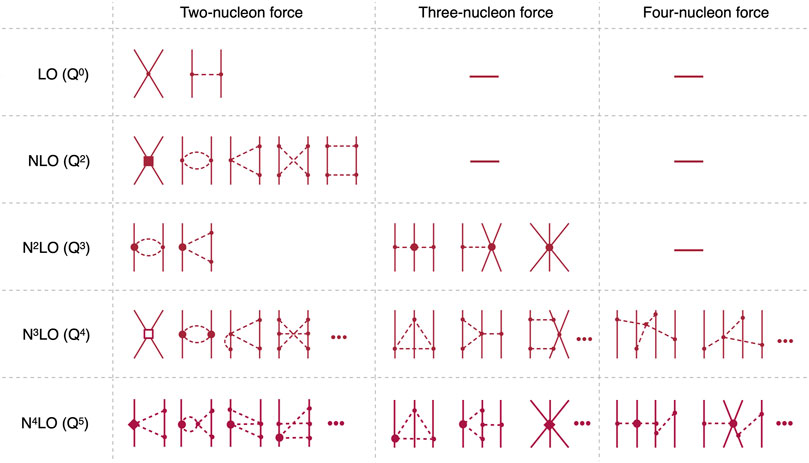
Figure 1. Expansion of nuclear forces. The diagrams are organized according to the power of
There are several points worth emphasizing. In the expansion, not only nucleon-nucleon (NN) interaction terms
From ChEFT, up to the 3N term, one can find nuclear Hamiltonian
with the kinetic energy term
with the creation (annihilation) operator
2.1.1 Radius operators
In addition to Hamiltonian, we briefly discuss the radius operators. Classically, an ms radius
with the normalization factor
Now, we can use the well-known partial wave decomposition formula for the plane wave function:
the ms radius is obtained as
We can apply Equation 4 to find, for example, the ms point-proton radius using the intrinsic point-proton density:
Here,
with the proton number
So far, the radii are classically defined. However, one can obtain the ms point-proton and point-neutron radius operators by applying the usual quantization procedure to Equations 5, 6, respectively. Writing the expectation value of
In nuclear physics, the most frequently measured is the charge radius, as it can be precisely measured by electromagnetic probes. To this end, one can begin with the intrinsic charge density
with nucleon mass
with proton/neutron Sachs form factors
with the
with
Here,
Finally, we note the 4th moment of charge density
Similar to the derivation of
with the 4th moment of proton/neutron charge density
with the ms proton/neutron magnetic radius
2.2 Many-body problem
The problem now is to solve the non-relativistic many-body Schrödinger equation
where
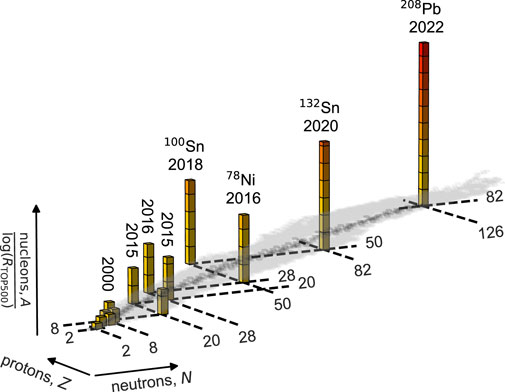
Figure 2. Progress of nuclear ab initio calculations over the last quarter century. The bars highlight years of the first realistic computations of doubly magic nuclei. The height of each bar corresponds to the mass number
A straightforward way to solve the equation would be to insert the completeness relation
The component of the vector
2.2.1 Normal ordering
To compute the medium and heavy-mass nuclei, one can use expansion methods based on a reference state
Here,
The brace indicates that the creation and annihilation operators are normal ordered with respect to
with the one-body density
2.2.2 Similarity transformation method
Beginning with Hamiltonian (Equation 9), one needs to evaluate the effects of the many-body correlations on top of the reference state. To incorporate the many-body correlations, the diagrammatic expansion or similarity transformation methods can be applied. As diagrammatic expansion methods, one can find many-body perturbation theory [61] and self-consistent Green’s function method [62, 63]. In this review, we quickly introduce the similarity transformation methods. The many-body Schrödinger equation is equivalent to
with
In general,
The transformation
In the coupled-cluster method [64] (CCM),
During the transformation (Equation 10), the many-body terms are induced. This can be seen by rewriting the transformation with the Baker–Campbell–Hausdorff (BCH) formula:
Assuming that the
The commutator of
This approximation is very efficient and usually accurate enough. Discussions on extensions beyond the two-body approximation in CCM and IMSRG can be found in Refs. [57, 59, 67–75].
In the IMSRG,
with
and the
with the s-dependent transformed Hamiltonian
2.3 Parameter optimization strategy
As discussed in Section 2.1, unknown LECs appear in ChEFT. Here, we summarize how the LECs of the frequently used interactions in this review were determined.
•
•N2LO
•
•
3 Charge radius
The nuclear charge radius is the most precisely measurable nuclear radius via electron scattering, laser spectroscopy, and muonic atom spectroscopy techniques. Here, we briefly discuss the recent progress in the charge radius studies from ab initio calculations. For simplicity, we omit angle brackets when writing expectation values. For example,
3.1 Light nuclei
Radius data are valuable for optimizing nuclear interactions. For example, the deuteron radius was used to check the quality of high-precision nucleon-nucleon (NN) potentials such as AV18 [96] and CD-Bonn [97]. Furthermore, the data of few-body systems are important to constrain the three-nucleon (3N) interaction. The inclusion of few-body data to optimize nuclear Hamiltonians has become feasible due to the developments in exact many-body techniques such as Faddeev [98], Faddeev-Yakubovsky [99], hyperspherical harmonics [100], no-core shell-model [101], and QMC [52, 53]. In ChEFT, two additional parameters
Moreover, the radii of few-body systems will be used to test the effect of the higher-order terms in the charge density operator. Deriving the analytical form of the charge radius operators is expected to be non-trivial for higher-order terms, especially the two-body contributions. In that case, computing the charge form factor and resorting to Equation 4 would be the most straightforward way. Indeed, in Table 1, within the numerical precision, one can see the equivalence between the two approaches, i.e., computing charge radii from the radius operator and the derivative of the form factor. All the radii are computed with the 1.8/2.0 (EM) interaction. The significant disagreement with the experimental 4He radius seems to be due to the updated proton radius [104].

Table 1. Radii of three-body systems and 4He, computed with the Jacobi-coordinate no-sore shell model [102,103] using the 1.8/2.0 (EM) [82, 83] interaction.
3.2 Medium-mass and heavy nuclei
In the late 2000s to early 2010s, applications of the many-body methods whose computational costs scale polynomially with the system size began, such as the coupled-cluster method (CCM) [64], self-consistent Green’s function approach [62, 63], and in-medium similarity renormalization group (IMSRG) [65, 66, 77] enabling us to access medium-mass nuclei [17]. Initially, the numerical calculations were mostly done for the ground-state energies; soon after, the calculations of radii began. Owing to the advancement, it became possible to optimize the nuclear interactions using both few-body data and, for example, 16O radius [7–9]. The inclusion of beyond-few-body data enables us to extrapolate our knowledge from well-known to less-known systems.
Numerical calculations for heavy nuclei
The study of charge radii provides insights into both nuclear interactions and the employed many-body approximations. Since the global behavior of charge radii appears to be well approximated by Hartree-Fock calculations, the deviations from experimental data indicate the insufficiency of the employed nuclear interaction. For example, the frequently used 1.8/2.0 (EM) interaction tends to predict too small radii [87]. Intuitively, smaller radii correspond to a higher density near the center of nuclei, which, in turn, is expected to lead to a higher saturation density in infinite nuclear matter calculations. Indeed, it was shown that the 1.8/2.0 (EM) interaction shows saturation at a higher density than empirical estimates [107]. Recently, based on a similar idea of the 1.8/2.0 (EM) interaction and optimizing with respect to the 16O data in addition to the few-body data, some nuclear interactions were developed. These interactions can accurately reproduce the ground-state energies and radii across the nuclear chart, including the neutron-rich region [10].
Recent advancements in experimental techniques, in particular laser spectroscopy, have significantly improved the precision of charge radii measurements, especially for exotic nuclei [4], providing stringent tests of employed nuclear Hamiltonian and many-body methods. Figure 3 shows the charge radii of nickel isotopes [108]. Panels (a) and (b) in the figure compare the results with the CC, SCGF, and IMSRG methods using the
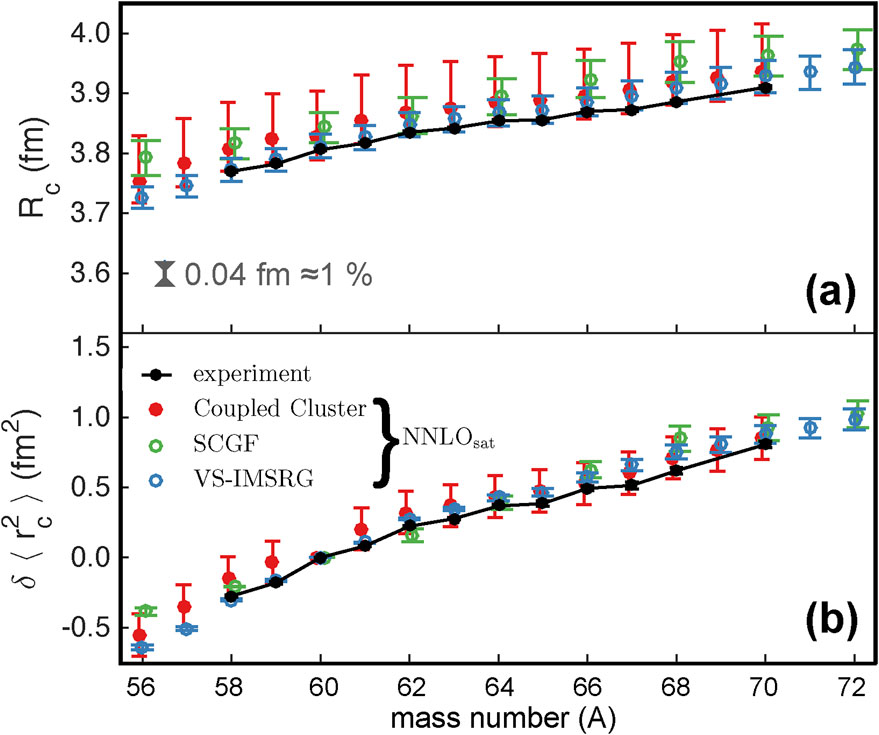
Figure 3. Charge radii for nickel isotopes. The experimental data [108] are illustrated with the points connected by the line. The absolute radii (a) and isotope shifts relative to 60Ni (b) are shown. All the theory results are computed with the
In Figure 4, the odd-even staggering (OES) of binding energy and charge radius of the copper isotopes are shown. The OES is defined as
Here,
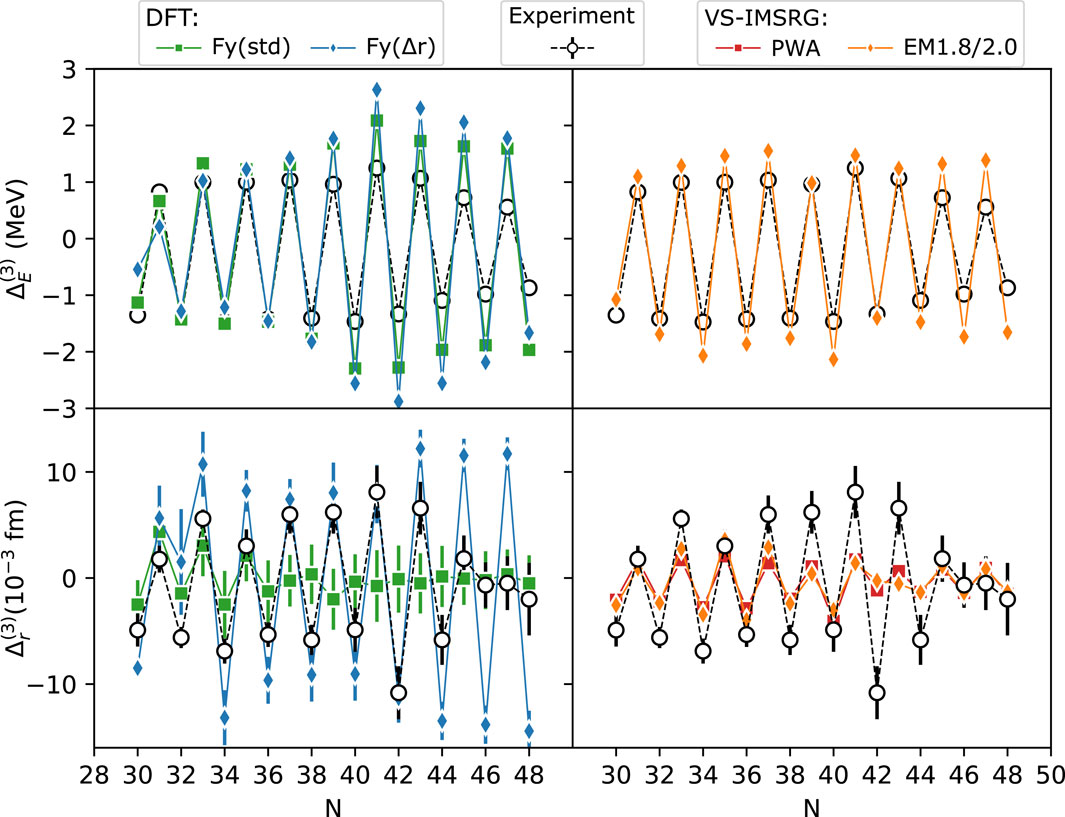
Figure 4. The OES of binding energies and charge radii in copper isotopes as a function of neutron number
Despite the success discussed above, we should not forget that many challenges remain in ab initio radius calculations [114–119]. A typical example would be the behavior in the calcium charge radii in 40–48Ca [109, 120]. The earlier shell-model calculation [120] demonstrated that the excitation across
4 Neutron skin thickness
The neutron skin thickness is a key quantity to connect our understanding of finite nuclei and infinite nuclear matter. A pioneering work with the ab initio framework was done by Hagen et al. [122], where they computed point-proton and neutron radii of 48Ca based on
208Pb is the most appealing nucleus in terms of neutron skin calculations as it shows a strong correlation with the nuclear matter properties. In Ref. [46], a first prediction for the neutron skin of 208Pb was made after incorporating the uncertainties due to both nuclear Hamiltonians and many-body approaches. The results are illustrated in Figure 5. In the work, starting from the 34 non-implausible interactions after the history-matching technique (green distribution), the interactions are weighted according to the reproduction of the selected data of 48Ca, to approximately obtain the posterior predictive distribution under the 48Ca data (blue distribution). The procedure was validated with the existing data, and the predicted
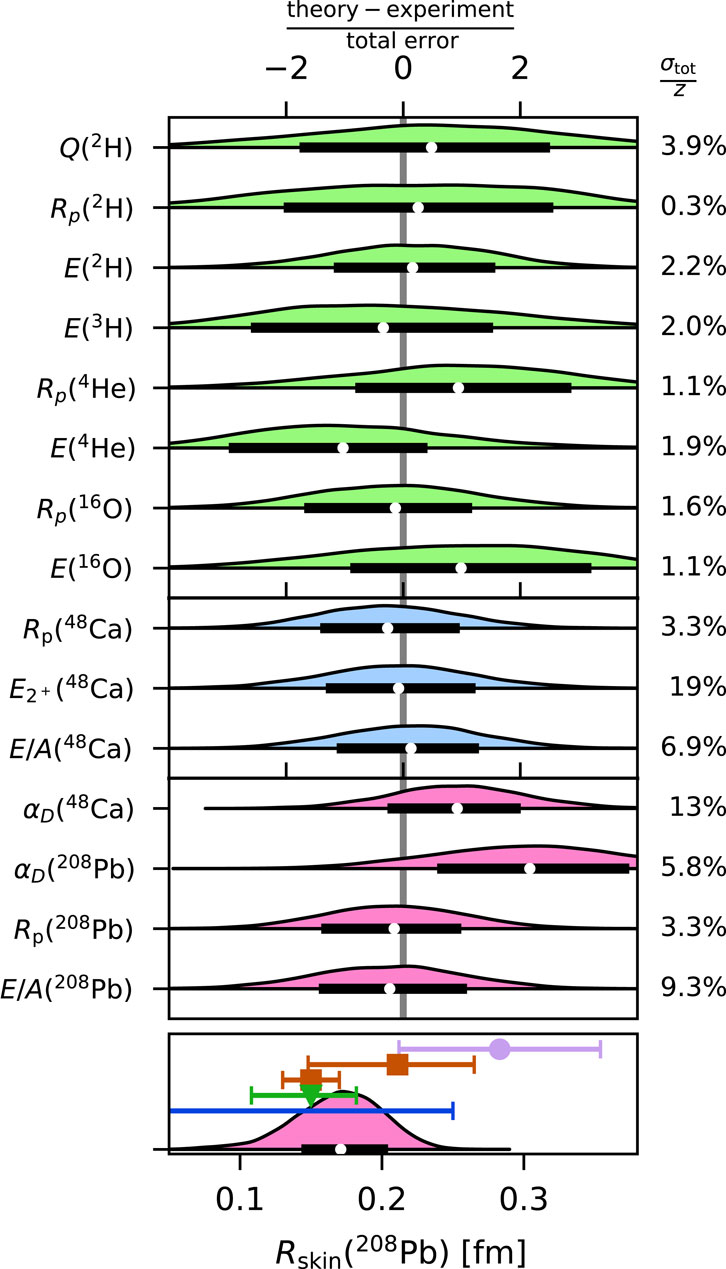
Figure 5. Probability distributions of selected observables for light to heavy nuclei. The green and blue distributions are for the observables used in the history-matching and likelihood calibration procedures, respectively. The posterior predictive distributions are indicated by the pink distributions. The nuclear observables shown are 2H quadrupole moment Q(2H), 2H point-proton radius Rp(2H), 2H ground-state energy E(2H), 3H ground-state energy E(3H), 4He point-proton radius Rp(4He), 4He ground-state energy E(4He), 16O point-proton radius Rp(16O), 16O ground-state energy E(16O), 48Ca point-proton radius Rp(48Ca), 48Ca
An experimentally clean extraction of neutron distribution is challenging as the neutron’s net electric charge vanishes. Parity-violating electron scattering (PVES) offers a model-independent way to access the neutron distribution because the process detects the contribution from the weak
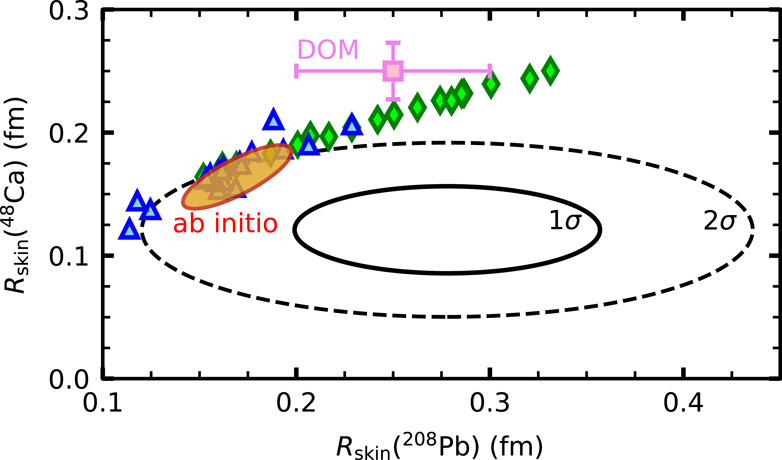
Figure 6. Neutron skin thickness of 48Ca and 208Pb. The CREX [124] and PREX [125] experimental results are shown by the ellipses. The green diamonds (blue triangles) represent the relativistic [131–136] (non-relativistic [137–142], [90], [143], [13]) mean-field theory results. The ab initio results [46] and dispersive optical model (DOM) results [144] are also shown. For the ab initio result, the correlated uncertainty is obtained based on the correlation observed in the 19 non-implausible interaction results, which are consistent with the estimated 68% credible ranges [46]. The figure is adapted from Ref. [124].
Finally, it is worth noting that there could be another observable that correlates with
5 Conclusion
This review focuses on the recent progress in ab initio studies for nuclear radii. The current nuclear ab initio framework consists of deriving the nuclear Hamiltonian and relevant operators from ChEFT and solving the quantum many-body problem with a controllable approximation. The advantage of the framework is that one can quantify the uncertainties at each step and propagate them to the final results. It is particularly useful to make a prediction for which performing experiments is difficult or even impossible.
The range of applicability of the ab initio calculations is rapidly expanding, which is primarily driven by developments in the many-body methods whose computational costs scale polynomially with the system size. Currently, 208Pb is accessible starting from ChEFT. However, it does not mean that one can accurately compute the properties of all the nuclei up to 208Pb. The emergence of collective phenomena, such as deformation and clustering, based on the underlying interactions is still an open question. The related recent efforts focusing on the deformation can be found in Refs. [153–163].
Recent developments in experimental techniques have significantly improved the precision of charge radii measurements, providing stringent tests of the theoretical models. We observed that the results from different ab initio many-body methods starting with the same nuclear Hamiltonian basically agree with each other. Through the comparison, we find a few percent uncertainty due to the many-body approximation for the near spherical systems. Although the reproduction of the absolute charge radii strongly depends on the employed interaction, the local trends seem to be well reproduced by the ab initio calculations. For example, the performance of the ab initio results looks better than that of DFT for the odd-even staggering of the charge radii in the copper isotopes.
As suggested in many earlier mean-field theory studies, precise knowledge of
Author contributions
TM: Writing – original draft, Writing – review and editing.
Funding
The author(s) declare that financial support was received for the research and/or publication of this article. This work is in part supported by JST ERATO Grant No. JPMJER2304, Japan.
Acknowledgments
The author would like to thank all his collaborators for fruitful discussions.
Conflict of interest
The authors declare that the research was conducted in the absence of any commercial or financial relationships that could be construed as a potential conflict of interest.
Generative AI statement
The author(s) declare that no Generative AI was used in the creation of this manuscript.
Publisher’s note
All claims expressed in this article are solely those of the authors and do not necessarily represent those of their affiliated organizations, or those of the publisher, the editors and the reviewers. Any product that may be evaluated in this article, or claim that may be made by its manufacturer, is not guaranteed or endorsed by the publisher.
References
1. Tanihata I. Neutron halo nuclei. J. Phys. G Nucl. Part. Phys. (1996) 22:157–98. doi:10.1088/0954-3899/22/2/004
2. Tanihata I, Savajols H, Kanungo R. Recent experimental progress in nuclear halo structure studies. Prog. Part. Nucl. Phys. (2013) 68:215–313. doi:10.1016/j.ppnp.2012.07.001
3. Ruiz RFG, Vernon AR. Emergence of simple patterns in many-body systems: from macroscopic objects to the atomic nucleus. Eur. Phys. J. A (2020) 56:136. doi:10.1140/epja/s10050-020-00134-8
4. Yang X, Wang S, Wilkins S, Ruiz RG. Laser spectroscopy for the study of exotic nuclei. Prog. Part. Nucl. Phys. (2023) 129:104005. doi:10.1016/j.ppnp.2022.104005
5. Reinhard PG, Nazarewicz W. Statistical correlations of nuclear quadrupole deformations and charge radii. Phys. Rev. C (2022) 106:014303. doi:10.1103/PhysRevC.106.014303
6. Naito T, Oishi T, Sagawa H, Wang Z. Comparative study on charge radii and their kinks at magic numbers. Phys. Rev. C (2023) 107:054307. doi:10.1103/PhysRevC.107.054307
7. Ekström A, Jansen GR, Wendt KA, Hagen G, Papenbrock T, Carlsson BD, et al. Accurate nuclear radii and binding energies from a chiral interaction. Phys. Rev. C (2015) 91:051301. doi:10.1103/PhysRevC.91.051301
8. Hüther T, Vobig K, Hebeler K, Machleidt R, Roth R. Family of chiral two-plus three-nucleon interactions for accurate nuclear structure studies. Phys. Lett. B (2020) 808:135651. doi:10.1016/j.physletb.2020.135651
9. Jiang WG, Ekström A, Forssén C, Hagen G, Jansen GR, Papenbrock T. Accurate bulk properties of nuclei from A = 2 to ∞ from potentials with Δ isobars. Phys. Rev. C (2020) 102:054301. doi:10.1103/PhysRevC.102.054301
10. Arthuis P, Hebeler K, Schwenk A. Neutron-rich nuclei and neutron skins from chiral low-resolution interactions. arXiv (2024). doi:10.48550/arXiv.2401.06675
11. Alex BB. Neutron radii in nuclei and the neutron equation of state. Phys. Rev. Lett. (2000) 85:5296–9. doi:10.1103/PhysRevLett.85.5296
12. Roca-Maza X, Centelles M, Viñas X, Warda M. Neutron skin of 208Pb, nuclear symmetry energy, and the parity radius experiment. Phys. Rev. Lett. (2011) 106:252501. doi:10.1103/PhysRevLett.106.252501
13. Erler J, Horowitz CJ, Nazarewicz W, Rafalski M, Reinhard PG. Energy density functional for nuclei and neutron stars. Phys. Rev. C (2013) 87:044320. doi:10.1103/PhysRevC.87.044320
14. Cadeddu M, Giunti C, Li YF, Zhang YY. Average CsI neutron density distribution from COHERENT data. Phys. Rev. Lett. (2018) 120:072501. doi:10.1103/PhysRevLett.120.072501
15. Ishii N, Aoki S, Hatsuda T. Nuclear force from lattice QCD. Phys. Rev. Lett. (2007) 99:022001. doi:10.1103/PhysRevLett.99.022001
16. Beane SR, Chang E, Cohen SD, Detmold W, Lin HW, Luu TC, et al. Light nuclei and hypernuclei from quantum chromodynamics in the limit of SU(3) flavor symmetry. Phys. Rev. D (2013) 87:034506. doi:10.1103/PhysRevD.87.034506
17. Hergert H. A guided tour of ab initio nuclear many-body theory. Front. Phys. (2020) 8:1. doi:10.3389/fphy.2020.00379
18. Ekström A, Forssén C, Hagen G, Jansen GR, Jiang W, Papenbrock T. What is ab initio in nuclear theory? Front. Phys. (2023) 11. doi:10.3389/fphy.2023.1129094
19. Yukawa H. On the interaction of elementary particles. I. Proc. Phys. Math. Soc. Japan (1935) 17:48–57. doi:10.11429/ppmsj1919.17.0_48
20. Weinberg S. Nuclear forces from chiral Lagrangians. Phys. Lett. B (1990) 251:288–92. doi:10.1016/0370-2693(90)90938-3
21. Weinberg S. Effective chiral Lagrangians for nucleon-pion interactions and nuclear forces. Nucl. Phys. B (1991) 363:3–18. doi:10.1016/0550-3213(91)90231-L
22. Weinberg S. Three-body interactions among nucleons and pions. Phys. Lett. B (1992) 295:114–21. doi:10.1016/0370-2693(92)90099-P
23. Epelbaum E, Krebs H, Reinert P. High-precision nuclear forces from chiral EFT: state-of-the-art, challenges, and outlook. Front. Phys. (2020) 8:1–30. doi:10.3389/fphy.2020.00098
24. Epelbaum E, Hammer HW, Meißner UG. Modern theory of nuclear forces. Rev. Mod. Phys. (2009) 81:1773–825. doi:10.1103/RevModPhys.81.1773
25. Machleidt R, Entem D. Chiral effective field theory and nuclear forces. Phys. Rep. (2011) 503:1–75. doi:10.1016/j.physrep.2011.02.001
26. Epelbaum E, Krebs H, Meißner UG. Improved chiral nucleon-nucleon potential up to next-to-next-to-next-to-leading order. Eur. Phys. J. A (2015) 51:53. doi:10.1140/epja/i2015-15053-8
27. Furnstahl RJ, Phillips DR, Wesolowski S. A recipe for EFT uncertainty quantification in nuclear physics. J. Phys. G Nucl. Part. Phys. (2015) 42:034028. doi:10.1088/0954-3899/42/3/034028
28. Melendez JA, Wesolowski S, Furnstahl RJ. Bayesian truncation errors in chiral effective field theory: nucleon-nucleon observables. Phys. Rev. C (2017) 96:024003. doi:10.1103/PhysRevC.96.024003
29. Melendez JA, Furnstahl RJ, Phillips DR, Pratola MT, Wesolowski S. Quantifying correlated truncation errors in effective field theory. Phys. Rev. C (2019) 100:044001. doi:10.1103/PhysRevC.100.044001
30. Park TS, Marcucci LE, Schiavilla R, Viviani M, Kievsky A, Rosati S, et al. Parameter-free effective field theory calculation for the solar proton-fusion and hep processes. Phys. Rev. C (2003) 67:055206. doi:10.1103/PhysRevC.67.055206
31. Pastore S, Girlanda L, Schiavilla R, Viviani M, Wiringa RB. Electromagnetic currents and magnetic moments in chiral effective field theory (χeft). Phys. Rev. C (2009) 80:034004. doi:10.1103/PhysRevC.80.034004
32. Pastore S, Pieper SC, Schiavilla R, Wiringa RB. Quantum Monte Carlo calculations of electromagnetic moments and transitions in A ≤ 9 nuclei with meson-exchange currents derived from chiral effective field theory. Phys. Rev. C (2013) 87:035503. doi:10.1103/PhysRevC.87.035503
33. Kölling S, Epelbaum E, Krebs H, Meißner UG. Two-pion exchange electromagnetic current in chiral effective field theory using the method of unitary transformation. Phys. Rev. C (2009) 80:045502. doi:10.1103/PhysRevC.80.045502
34. Kölling S, Epelbaum E, Krebs H, Meißner UG. Two-nucleon electromagnetic current in chiral effective field theory: one-pion exchange and short-range contributions. Phys. Rev. C (2011) 84:054008. doi:10.1103/PhysRevC.84.054008
35. Krebs H, Epelbaum E, Meißner UG. Nuclear axial current operators to fourth order in chiral effective field theory. Ann. Phys. (N. Y). (2017) 378:317–95. doi:10.1016/j.aop.2017.01.021
36. Krebs H, Epelbaum E, Meißner UG. Nuclear electromagnetic currents to fourth order in chiral effective field theory. Few-body Syst. (2019) 60:31. doi:10.1007/s00601-019-1500-5
37. Gysbers P, Hagen G, Holt JD, Jansen GR, Morris TD, Navrátil P, et al. Discrepancy between experimental and theoretical β-decay rates resolved from first principles. Nat. Phys. (2019) 15:428–31. doi:10.1038/s41567-019-0450-7
38. Friman-Gayer U, Romig C, Hüther T, Albe K, Bacca S, Beck T, et al. Role of chiral two-body currents in 6Li magnetic properties in light of a new precision measurement wit. Phys. Rev. Lett. (2021) 126:102501. doi:10.1103/PhysRevLett.126.102501
39. Miyagi T, Cao X, Seutin R, Bacca S, Ruiz RFG, Hebeler K, et al. Impact of two-body currents on magnetic dipole moments of nuclei. Phys. Rev. Lett. (2024) 132:232503. doi:10.1103/PhysRevLett.132.232503
40. Chambers-Wall G, Gnech A, King GB, Pastore S, Piarulli M, Schiavilla R, et al. Quantum Monte Carlo calculations of magnetic form factors in light nuclei. Phys. Rev. Lett. (2024) 133:212501. doi:10.1103/PhysRevLett.133.212501
41. Pastore S, Girlanda L, Schiavilla R, Viviani M. Two-nucleon electromagnetic charge operator in chiral effective field theory χEFT up to one loop. Phys. Rev. C (2011) 84:024001. doi:10.1103/PhysRevC.84.024001
42. Krebs H. Nuclear currents in chiral effective field theory. Eur. Phys. J. A (2020) 56:234. doi:10.1140/epja/s10050-020-00230-9
43. King GB, Chambers-Wall G, Gnech A, Pastore S, Piarulli M, Wiringa RB. Longitudinal form factors of A ≤ 10 nuclei in a chiral effective field theory approach. Phys. Rev. C (2024) 110:054325. doi:10.1103/PhysRevC.110.054325
44. Door M, Yeh CH, Heinz M, Kirk F, Lyu C, Miyagi T, et al. Search for new bosons with ytterbium isotope shifts. arXiv:2403 (2024) 07792. doi:10.1103/PhysRevLett.134.063002
45. Kurasawa H, Suzuki T. The nth-order moment of the nuclear charge density and contribution from the neutrons. Prog. Theor. Exp. Phys. (2019) 2019. doi:10.1093/ptep/ptz121
46. Hu B, Jiang W, Miyagi T, Sun Z, Ekström A, Forssén C, et al. Ab initio predictions link the neutron skin of 208Pb to nuclear forces. Nat. Phys. (2022) 18:1196–200. doi:10.1038/s41567-022-01715-8
47. Hergert H, Binder S, Calci A, Langhammer J, Roth R. Ab initio calculations of even oxygen isotopes with chiral two- plus three-nucleon interactions. Phys. Rev. Lett. (2013) 110:242501. doi:10.1103/PhysRevLett.110.242501
48. Roth R, Calci A, Langhammer J, Binder S. Evolved chiral NN + 3N Hamiltonians for ab initio nuclear structure calculations. Phys. Rev. C (2014) 90:024325. doi:10.1103/PhysRevC.90.024325
49. Hao Y, Navrátil P, Norrgard EB, Iliaš M, Eliav E, Timmermans RGE, et al. Nuclear spin-dependent parity-violating effects in light polyatomic molecules. Phys. Rev. A (2020) 102:052828. doi:10.1103/PhysRevA.102.052828
50. Froese P, Navrátil P. Ab initio calculations of electric dipole moments of light nuclei. Phys. Rev. C (2021) 104:025502. doi:10.1103/PhysRevC.104.025502
51. Pieper SC, Wiringa RB. Quantum monte carlo calculations of light nuclei. Annu. Rev. Nucl. Part. Sci. (2001) 51:53–90. doi:10.1146/annurev.nucl.51.101701.132506
52. Carlson J, Gandolfi S, Pederiva F, Pieper SC, Schiavilla R, Schmidt KE, et al. Quantum Monte Carlo methods for nuclear physics. Rev. Mod. Phys. (2015) 87:1067–118. doi:10.1103/RevModPhys.87.1067
53. Gandolfi S, Lonardoni D, Lovato A, Piarulli M. Atomic nuclei from quantum Monte Carlo calculations with chiral EFT interactions. Front. Phys. (2020) 8. doi:10.3389/fphy.2020.00117
54. Lee D. Lattice simulations for few- and many-body systems. Prog. Part. Nucl. Phys. (2009) 63:117–54. doi:10.1016/j.ppnp.2008.12.001
55. Lähde TA, Meißner UG. Nuclear lattice effective field theory. In: Lecture notes in physics, 957. Cham: Springer International Publishing (2019). doi:10.1007/978-3-030-14189-9
56. Elhatisari S, Bovermann L, Ma YZ, Epelbaum E, Frame D, Hildenbrand F, et al. Wavefunction matching for solving quantum many-body problems. Nature (2024) 630:59–63. doi:10.1038/s41586-024-07422-z
57. Hagen G, Papenbrock T, Dean DJ, Schwenk A, Nogga A, Włoch M, et al. Coupled-cluster theory for three-body Hamiltonians. Phys. Rev. C (2007) 76:034302. doi:10.1103/PhysRevC.76.034302
58. Roth R, Binder S, Vobig K, Calci A, Langhammer J, Navrátil P. Medium-mass nuclei with normal-ordered chiral NN + 3N interactions. Phys. Rev. Lett. (2012) 109:052501. doi:10.1103/PhysRevLett.109.052501
59. Binder S, Langhammer J, Calci A, Navrátil P, Roth R. Ab initio calculations of medium-mass nuclei with explicit chiral 3N interactions. Phys. Rev. C (2013) 87:021303. doi:10.1103/PhysRevC.87.021303
60. Djärv T, Ekström A, Forssén C, Jansen GR. Normal-ordering approximations and translational (non)invariance. Phys. Rev. C (2021) 104:024324. doi:10.1103/PhysRevC.104.024324
61. Tichai A, Roth R, Duguet T. Many-body perturbation theories for finite nuclei. Front. Phys. (2020) 8:1–29. doi:10.3389/fphy.2020.00164
62. Dickhoff W, Barbieri C. Self-consistent Green’s function method for nuclei and nuclear matter. Prog. Part. Nucl. Phys. (2004) 52:377–496. doi:10.1016/j.ppnp.2004.02.038
63. Somà V. Self-consistent Green’s function theory for atomic nuclei. Front. Phys. (2020) 8:1–31. doi:10.3389/fphy.2020.00340
64. Hagen G, Papenbrock T, Hjorth-Jensen M, Dean DJ. Coupled-cluster computations of atomic nuclei. Rep Prog. Phys. (2014) 77:096302. doi:10.1088/0034-4885/77/9/096302
65. Hergert H, Bogner S, Morris T, Schwenk A, Tsukiyama K. The In-Medium Similarity Renormalization Group: a novel ab initio method for nuclei. Phys. Rep. (2016) 621:165–222. doi:10.1016/j.physrep.2015.12.007
66. Hergert H. In-medium similarity renormalization group for closed and open-shell nuclei. Phys. Scr. (2017) 92:023002. doi:10.1088/1402-4896/92/2/023002
67. Roth R, Gour JR, Piecuch P. Ab initio coupled-cluster and configuration interaction calculations for O 16 using the V UCOM interaction. Phys. Rev. C (2009) 79:054325. doi:10.1103/PhysRevC.79.054325
68. Morris TD, Simonis J, Stroberg SR, Stumpf C, Hagen G, Holt JD, et al. Structure of the lightest tin isotopes. Phys. Rev. Lett. (2018) 120:152503. doi:10.1103/PhysRevLett.120.152503
69. Miorelli M, Bacca S, Hagen G, Papenbrock T. Computing the dipole polarizability of 48Ca with increased precision. Phys. Rev. C (2018) 98:014324. doi:10.1103/PhysRevC.98.014324
70. Heinz M, Tichai A, Hoppe J, Hebeler K, Schwenk A. In-medium similarity renormalization group with three-body operators. Phys. Rev. C (2021) 103:044318. doi:10.1103/PhysRevC.103.044318
71. Bonaiti F, Bacca S, Hagen G. Ab initio coupled-cluster calculations of ground and dipole excited states in He 8. Phys. Rev. C (2022) 105:034313. doi:10.1103/PhysRevC.105.034313
72. Bonaiti F, Bacca S, Hagen G, Jansen GR. Electromagnetic observables of open-shell nuclei from coupled-cluster theory. Phys. Rev. C (2024) 110:044306. doi:10.1103/PhysRevC.110.044306
73. He BC, Stroberg SR. Factorized approximation to the in-medium similarity renormalization group IMSRG(3). Phys. Rev. C (2024) 110:044317. doi:10.1103/PhysRevC.110.044317
74. Stroberg SR, Morris TD, He BC. In-medium similarity renormalization group with flowing 3-body operators, and approximations thereof. Phys. Rev. C (2024) 110:044316. doi:10.1103/PhysRevC.110.044316
75. Heinz M, Miyagi T, Stroberg SR, Tichai A, Hebeler K, Schwenk A. Improved structure of calcium isotopes from ab initio calculations. Phys. Rev. C (2024) 111:034311. doi:10.1103/PhysRevC.111.034311
76. Morris TD, Parzuchowski NM, Bogner SK. Magnus expansion and in-medium similarity renormalization group. Phys. Rev. C (2015) 92:034331. doi:10.1103/PhysRevC.92.034331
77. Stroberg SR, Hergert H, Bogner SK, Holt JD. Nonempirical interactions for the nuclear shell model: an update. Annu. Rev. Nucl. Part. Sci. (2019) 69:307–62. doi:10.1146/annurev-nucl-101917-021120
78. Caurier E, Nowacki F. Present status of shell model techniques. Acta Phys. Pol. B (1999) 30:705.
79. Brown B, Rae W. The shell-model code NuShellX@MSU. Nucl. Data Sheets (2014) 120:115–8. doi:10.1016/j.nds.2014.07.022
80. Johnson CW, Ormand WE, McElvain KS, Shan H. BIGSTICK: a flexible configuration-interaction shell-model code. arXiv:1801 (2018) 08432. doi:10.48550/arXiv.1801.08432
81. Shimizu N, Mizusaki T, Utsuno Y, Tsunoda Y. Thick-restart block Lanczos method for large-scale shell-model calculations. Comput. Phys. Commun. (2019) 244:372–84. doi:10.1016/j.cpc.2019.06.011
82. Hebeler K, Bogner SK, Furnstahl RJ, Nogga A, Schwenk A. Improved nuclear matter calculations from chiral low-momentum interactions. Phys. Rev. C (2011) 83:031301. doi:10.1103/PhysRevC.83.031301
83. Entem DR, Machleidt R. Accurate charge-dependent nucleon-nucleon potential at fourth order of chiral perturbation theory. Phys. Rev. C (2003) 68:041001. doi:10.1103/PhysRevC.68.041001
84. Bogner SK, Furnstahl RJ, Perry RJ. Similarity renormalization group for nucleon-nucleon interactions. Phys. Rev. C (2007) 75:061001. doi:10.1103/PhysRevC.75.061001
85. Rentmeester MCM, Timmermans RGE, de Swart JJ. Determination of the chiral coupling constants c3 and c4 in new pp and np partial-wave analyses. Phys. Rev. C (2003) 67:044001. doi:10.1103/PhysRevC.67.044001
86. Epelbaum E, Glöckle W, Meißner UG. The two-nucleon system at next-to-next-to-next-to-leading order. Nucl. Phys. A (2005) 747:362–424. doi:10.1016/j.nuclphysa.2004.09.107
87. Simonis J, Stroberg SR, Hebeler K, Holt JD, Schwenk A. Saturation with chiral interactions and consequences for finite nuclei. Phys. Rev. C (2017) 96:014303. doi:10.1103/PhysRevC.96.014303
88. Stroberg SR, Holt JD, Schwenk A, Simonis J. Ab initio limits of atomic nuclei. Phys. Rev. Lett. (2021) 126:022501. doi:10.1103/PhysRevLett.126.022501
89. Miyagi T, Stroberg SR, Navrátil P, Hebeler K, Holt JD. Converged ab initio calculations of heavy nuclei. Phys. Rev. C (2022) 105:014302. doi:10.1103/PhysRevC.105.014302
90. Kortelainen M, Lesinski T, Moré J, Nazarewicz W, Sarich J, Schunck N, et al. Nuclear energy density optimization. Phys. Rev. C (2010) 82:024313. doi:10.1103/PhysRevC.82.024313
91. Ekström A, Hagen G, Morris TD, Papenbrock T, Schwartz PD. Δ isobars and nuclear saturation. Phys. Rev. C (2018) 97:024332. doi:10.1103/PhysRevC.97.024332
92. Kondo Y, Achouri NL, Falou HA, Atar L, Aumann T, Baba H, et al. First observation of 28O. Nature (2023) 620:965–70. doi:10.1038/s41586-023-06352-6
93. Jiang WG, Forssén C, Djärv T, Hagen G. Nuclear-matter saturation and symmetry energy within Δ -full chiral effective field theory. Phys. Rev. C (2024) 109:L061302. doi:10.1103/PhysRevC.109.L061302
94. Bower RG, Goldstein M, Vernon I. Galaxy formation: a Bayesian uncertainty analysis. Bayesian Anal (2010) 5. doi:10.1214/10-BA524
95. Vernon I, Goldstein M, Bower R. Galaxy Formation: bayesian history matching for the observable universe. Stat. Sci. (2014) 29. doi:10.1214/12-STS412
96. Wiringa RB, Stoks VGJ, Schiavilla R. Accurate nucleon-nucleon potential with charge-independence breaking. Phys. Rev. C (1995) 51:38–51. doi:10.1103/PhysRevC.51.38
97. Machleidt R. High-precision, charge-dependent Bonn nucleon-nucleon potential. Phys. Rev. C (2001) 63:024001. doi:10.1103/PhysRevC.63.024001
99. Yakubovsky O. On the Integral equations in the theory of N particle scattering. Sov.J.Nucl.Phys. (1967) 5:937.
100. Marcucci LE, Dohet-Eraly J, Girlanda L, Gnech A, Kievsky A, Viviani M. The hyperspherical harmonics method: a tool for testing and improving nuclear interaction models. Front. Phys. (2020) 8. doi:10.3389/fphy.2020.00069
101. Barrett BR, Navrátil P, Vary JP. Ab initio no core shell model. Prog. Part. Nucl. Phys. (2013) 69:131–81. doi:10.1016/j.ppnp.2012.10.003
102. Navrátil P, Barrett BR. Four-nucleon shell-model calculations in a Faddeev-like approach. Phys. Rev. C (1999) 59:1906–18. doi:10.1103/PhysRevC.59.1906
103. Navrátil P, Vary JP, Barrett BR. Large-basis ab initio no-core shell model and its application to 12 C. Phys. Rev. C (2000) 62:054311. doi:10.1103/PhysRevC.62.054311
104. Navas S, Amsler C, Gutsche T, Hanhart C, Hernández-Rey JJ, Lourenço C, et al. Review of particle physics. Phys. Rev. D (2024) 110:030001. doi:10.1103/PhysRevD.110.030001
105. Binder S, Langhammer J, Calci A, Roth R. Ab initio path to heavy nuclei. Phys. Lett. B (2014) 736:119–23. doi:10.1016/j.physletb.2014.07.010
106. Arthuis P, Barbieri C, Vorabbi M, Finelli P. Ab initio computation of charge densities for Sn and Xe isotopes. Phys. Rev. Lett. (2020) 125:182501. doi:10.1103/PhysRevLett.125.182501
107. Drischler C, Hebeler K, Schwenk A. Chiral interactions up to next-to-next-to-next-to-leading order and nuclear saturation. Phys. Rev. Lett. (2019) 122:042501. doi:10.1103/PhysRevLett.122.042501
108. Malbrunot-Ettenauer S, Kaufmann S, Bacca S, Barbieri C, Billowes J, Bissell ML, et al. Nuclear charge radii of the nickel isotopes 58–68,70Ni. Phys. Rev. Lett. (2022) 128:022502. doi:10.1103/PhysRevLett.128.022502
109. Reinhard PG, Nazarewicz W. Toward a global description of nuclear charge radii: exploring the Fayans energy density functional. Phys. Rev. C (2017) 95:064328. doi:10.1103/PhysRevC.95.064328
110. Gorges C, Rodríguez LV, Balabanski DL, Bissell ML, Blaum K, Cheal B, et al. Laser spectroscopy of neutron-rich tin isotopes: a discontinuity in charge radii across the N=82 shell closure. Phys. Rev. Lett. (2019) 122:192502. doi:10.1103/PhysRevLett.122.192502
111. Miller AJ, Minamisono K, Klose A, Garand D, Kujawa C, Lantis JD, et al. Proton superfluidity and charge radii in proton-rich calcium isotopes. Nat. Phys. (2019) 15:432–6. doi:10.1038/s41567-019-0416-9
112. de Groote RP, Billowes J, Binnersley CL, Bissell ML, Cocolios TE, Day Goodacre T, et al. Measurement and microscopic description of oddˆˆe2ˆˆ80ˆˆ93even staggering of charge radii of exotic copper isotopes. Nat. Phys. (2020) 16:620–4. doi:10.1038/s41567-020-0868-y
113. Karthein J, Ricketts CM, Garcia Ruiz RF, Billowes J, Binnersley CL, Cocolios TE, et al. Electromagnetic properties of indium isotopes illuminate the doubly magic character of 100Sn. Nat. Phys. (2024) 20:1719–25. doi:10.1038/s41567-024-02612-y
114. Garcia Ruiz RF, Bissell ML, Blaum K, Ekström A, Frömmgen N, Hagen G, et al. Unexpectedly large charge radii of neutron-rich calcium isotopes. Nat. Phys. (2016) 12:594–8. doi:10.1038/nphys3645
115. Novario SJ, Hagen G, Jansen GR, Papenbrock T. Charge radii of exotic neon and magnesium isotopes. Phys. Rev. C (2020) 102:051303. doi:10.1103/PhysRevC.102.051303
116. Heylen H, Devlin CS, Gins W, Bissell ML, Blaum K, Cheal B, et al. High-resolution laser spectroscopy of 27–32Al. Phys. Rev. C (2021) 103:014318. doi:10.1103/PhysRevC.103.014318
117. Koszorús Á, Vormawah L, Beerwerth R, Bissell M, Campbell P, Cheal B, et al. Proton-neutron pairing correlations in the self-conjugate nucleus 42Sc. Phys. Lett. B (2021) 819:136439. doi:10.1016/j.physletb.2021.136439
118. Koszorús Á, Yang XF, Jiang WG, Novario SJ, Bai SW, Billowes J, et al. Publisher Correction: charge radii of exotic potassium isotopes challenge nuclear theory and the magic character of N = 32. Nat. Phys. (2021) 17:539. doi:10.1038/s41567-021-01192-5
119. König K, Fritzsche S, Hagen G, Holt JD, Klose A, Lantis J, et al. Surprising charge-radius kink in the Sc isotopes at N = 20. Phys. Rev. Lett. (2023) 131:102501. doi:10.1103/PhysRevLett.131.102501
120. Caurier E, Langanke K, Martínez-Pinedo G, Nowacki F, Vogel P. Shell model description of isotope shifts in calcium. Phys. Lett. B (2001) 522:240–4. doi:10.1016/S0370-2693(01)01246-1
121. Miyagi T, Stroberg SR, Holt JD, Shimizu N. Ab initio multishell valence-space Hamiltonians and the island of inversion. Phys. Rev. C (2020) 102:034320. doi:10.1103/PhysRevC.102.034320
122. Hagen G, Ekström A, Forssén C, Jansen GR, Nazarewicz W, Papenbrock T, et al. Neutron and weak-charge distributions of the 48 Ca nucleus. Nat. Phys. (2016) 12:186–90. doi:10.1038/nphys3529
123. Birkhan J, Miorelli M, Bacca S, Bassauer S, Bertulani CA, Hagen G, et al. Electric dipole polarizability of 48Ca and implications for the neutron skin. Phys. Rev. Lett. (2017) 118:252501. doi:10.1103/PhysRevLett.118.252501
124. Adhikari D, Albataineh H, Androic D, Aniol KA, Armstrong DS, Averett T, et al. Precision determination of the neutral weak form factor of 48Ca. Phys. Rev. Lett. (2022) 129:042501. doi:10.1103/PhysRevLett.129.042501
125. Adhikari D, Albataineh H, Androic D, Aniol K, Armstrong DS, Averett T, et al. Accurate determination of the neutron skin thickness of 208Pb through parity-violation in electron scat. Phys. Rev. Lett. (2021) 126:172502. doi:10.1103/PhysRevLett.126.172502
126. Trzcińska A, Jastrzȩbski J, Lubiński P, Hartmann FJ, Schmidt R, von Egidy T, et al. Neutron density distributions deduced from antiprotonic atoms. Phys. Rev. Lett. (2001) 87:082501. doi:10.1103/PhysRevLett.87.082501
127. Zenihiro J, Sakaguchi H, Murakami T, Yosoi M, Yasuda Y, Terashima S, et al. Neutron density distributions of 204,206,208Pb deduced via proton elastic scattering at Ep=295 MeV. Phys. Rev. C (2010) 82:044611. doi:10.1103/PhysRevC.82.044611
128. Tarbert CM, Watts DP, Glazier DI, Aguar P, Ahrens J, Annand JRM, et al. Neutron skin of 208Pb from coherent pion photoproduction. Phys. Rev. Lett. (2014) 112:242502. doi:10.1103/PhysRevLett.112.242502
129. Fattoyev FJ, Piekarewicz J, Horowitz CJ. Neutron skins and neutron stars in the multimessenger era. Phys. Rev. Lett. (2018) 120:172702. doi:10.1103/PhysRevLett.120.172702
130. Hu B, Jiang W, Miyagi T, Sun Z, Ekström A, Forssén C, et al. Author Correction: ab initio predictions link the neutron skin of 208Pb to nuclear forces. Nat. Phys. (2024) 20:169. doi:10.1038/s41567-023-02324-9
131. Todd-Rutel BG, Piekarewicz J. Neutron-rich nuclei and neutron stars: a new accurately calibrated interaction for the study of neutron-rich matter. Phys. Rev. Lett. (2005) 95:122501. doi:10.1103/PhysRevLett.95.122501
132. Fattoyev FJ, Horowitz CJ, Piekarewicz J, Shen G. Relativistic effective interaction for nuclei, giant resonances, and neutron stars. Phys. Rev. C (2010) 82:055803. doi:10.1103/PhysRevC.82.055803
133. Fattoyev FJ, Piekarewicz J. Has a thick neutron skin in 208Pb been ruled out? Phys. Rev. Lett. (2013) 111:162501. doi:10.1103/PhysRevLett.111.162501
134. Chen WC, Piekarewicz J. Building relativistic mean field models for finite nuclei and neutron stars. Phys. Rev. C (2014) 90:044305. doi:10.1103/PhysRevC.90.044305
135. Chen WC, Piekarewicz J. Searching for isovector signatures in the neutron-rich oxygen and calcium isotopes. Phys. Lett. B (2015) 748:284–8. doi:10.1016/j.physletb.2015.07.020
136. Reed BT, Fattoyev FJ, Horowitz CJ, Piekarewicz J. Implications of PREX-2 on the equation of state of neutron-rich matter. Phys. Rev. Lett. (2021) 126:172503. doi:10.1103/PhysRevLett.126.172503
137. Skyrme T. The effective nuclear potential. Nucl. Phys. (1958) 9:615–34. doi:10.1016/0029-5582(58)90345-6
138. Vautherin D, Brink DM. Hartree-Fock calculations with skyrme’s interaction. I. Spherical nuclei. Phys. Rev. C (1972) 5:626–47. doi:10.1103/PhysRevC.5.626
139. Bartel J, Quentin P, Brack M, Guet C, Håkansson HB. Towards a better parametrisation of Skyrme-like effective forces: a critical study of the SkM force. Nucl. Phys. A (1982) 386:79–100. doi:10.1016/0375-9474(82)90403-1
140. Chabanat E, Bonche P, Haensel P, Meyer J, Schaeffer R. A Skyrme parametrization from subnuclear to neutron star densities Part II. Nuclei far from stabilities. Nucl. Phys. A (1998) 635:231–56. doi:10.1016/S0375-9474(98)00180-8
141. Horowitz CJ, Piekarewicz J. Neutron radii of 208Pb and neutron stars. Phys. Rev. C (2001) 64:062802. doi:10.1103/PhysRevC.64.062802
142. Klüpfel P, Reinhard PG, Bürvenich TJ, Maruhn JA. Variations on a theme by Skyrme: a systematic study of adjustments of model parameters. Phys. Rev. C (2009) 79:034310. doi:10.1103/PhysRevC.79.034310
143. Kortelainen M, McDonnell J, Nazarewicz W, Reinhard PG, Sarich J, Schunck N, et al. Nuclear energy density optimization: large deformations. Phys. Rev. C (2012) 85:024304. doi:10.1103/PhysRevC.85.024304
144. Atkinson MC, Mahzoon MH, Keim MA, Bordelon BA, Pruitt CD, Charity RJ, et al. Dispersive optical model analysis of 208Pb generating a neutron-skin prediction beyond the mean field. Phys. Rev. C (2020) 101:044303. doi:10.1103/PhysRevC.101.044303
145. Heinz M, Hoferichter M, Miyagi T, Noël F, Schwenk A. Ab initio calculations of overlap integrals for μ → e conversion in nuclei. arXiv:2412 04545 (2024). doi:10.48550/arXiv.2412.04545
146. Brown BA. Mirror charge radii and the neutron equation of state. Phys. Rev. Lett. (2017) 119:122502–5. doi:10.1103/PhysRevLett.119.122502
147. Yang J, Piekarewicz J. Difference in proton radii of mirror nuclei as a possible surrogate for the neutron skin. Phys. Rev. C (2018) 97:014314. doi:10.1103/PhysRevC.97.014314
148. Brown BA, Minamisono K, Piekarewicz J, Hergert H, Garand D, Klose A, et al. Implications of the 36Ca-36S and 38Ca-38Ar difference in mirror charge radii on the neutron matter equation of state. Phys. Rev. Res. (2020) 2:022035. doi:10.1103/PhysRevResearch.2.022035
149. Pineda SV, König K, Rossi DM, Brown BA, Incorvati A, Lantis J, et al. Charge radius of neutron-deficient ^{54}Ni and symmetry energy constraints using the difference in mirror pair charge radii. Phys. Rev. Lett. (2021) 127:182503. doi:10.1103/PhysRevLett.127.182503
150. Bano P, Pattnaik SP, Centelles M, Viñas X, Routray TR. Correlations between charge radii differences of mirror nuclei and stellar observables. Phys. Rev. C (2023) 108:015802. doi:10.1103/PhysRevC.108.015802
151. Novario SJ, Lonardoni D, Gandolfi S, Hagen G. Trends of neutron skins and radii of mirror nuclei from first principles. Phys. Rev. Lett. (2023) 130:032501. doi:10.1103/PhysRevLett.130.032501
152. Hu BS. How do mirror charge radii constrain density dependence of the symmetry energy? Phys. Lett. B (2024) 857:138969. doi:10.1016/j.physletb.2024.138969
153. Yao JM, Bally B, Engel J, Wirth R, Rodríguez TR, Hergert H. Ab initio treatment of collective correlations and the neutrinoless double beta decay of Ca 48. Phys. Rev. Lett. (2020) 124:232501. doi:10.1103/PhysRevLett.124.232501
154. Frosini M, Duguet T, Ebran JP, Bally B, Hergert H, Rodríguez TR, et al. Multi-reference many-body perturbation theory for nuclei. Eur. Phys. J. A (2022) 58:64. doi:10.1140/epja/s10050-022-00694-x
155. Frosini M, Duguet T, Ebran JP, Bally B, Mongelli T, Rodríguez TR, et al. Multi-reference many-body perturbation theory for nuclei. Eur. Phys. J. A (2022) 58:63. doi:10.1140/epja/s10050-022-00693-y
156. Frosini M, Duguet T, Ebran JP, Somà V. Multi-reference many-body perturbation theory for nuclei. Eur. Phys. J. A (2022) 58:62. doi:10.1140/epja/s10050-022-00692-z
157. Hagen G, Novario SJ, Sun ZH, Papenbrock T, Jansen GR, Lietz JG, et al. Angular-momentum projection in coupled-cluster theory: structure of 34Mg. Phys. Rev. C (2022) 105:064311. doi:10.1103/PhysRevC.105.064311
158. Ekström A, Forssén C, Hagen G, Jansen GR, Papenbrock T, Sun ZH. How chiral forces shape neutron-rich Ne and Mg nuclei. arXiv:2305 (2023) 06955. doi:10.48550/arXiv.2305.06955
159. Sun ZH, Djärv TR, Hagen G, Jansen GR, Papenbrock T. Structure of odd-mass Ne, Na, and Mg nuclei. arXiv:2409 (2024) 02279. doi:10.1103/PhysRevC.111.044304
160. Sun ZH, Ekström A, Forssén C, Hagen G, Jansen GR, Papenbrock T. Multiscale physics of atomic nuclei from first principles. arXiv:2404 (2024) 00058. doi:10.1103/PhysRevX.15.011028
161. Hu B, Sun Z, Hagen G, Jansen G, Papenbrock T. Ab initio computations from 78Ni towards 70Ca along neutron number N = 50. Phys. Lett. B (2024) 858:139010. doi:10.1016/j.physletb.2024.139010
162. Hu BS, Sun ZH, Hagen G, Papenbrock T. Ab initio computations of strongly deformed nuclei near Zr 80. Phys. Rev. C (2024) 110:L011302. doi:10.1103/PhysRevC.110.L011302
Keywords: nuclear radius, neutron skin thickness, nuclear structure, nuclear force, nuclear ab initio calculation
Citation: Miyagi T (2025) Nuclear radii from first principles. Front. Phys. 13:1581854. doi: 10.3389/fphy.2025.1581854
Received: 23 February 2025; Accepted: 18 April 2025;
Published: 09 May 2025.
Edited by:
Masayuki Matsuzaki, Fukuoka University of Education, JapanReviewed by:
Mengoni Daniele, National Institute of Nuclear Physics of Padova, ItalyMichio Kohno, Osaka University, Japan
Copyright © 2025 Miyagi. This is an open-access article distributed under the terms of the Creative Commons Attribution License (CC BY). The use, distribution or reproduction in other forums is permitted, provided the original author(s) and the copyright owner(s) are credited and that the original publication in this journal is cited, in accordance with accepted academic practice. No use, distribution or reproduction is permitted which does not comply with these terms.
*Correspondence: Takayuki Miyagi, bWl5YWdpQG51Y2wucGgudHN1a3ViYS5hYy5qcA==
 Takayuki Miyagi
Takayuki Miyagi